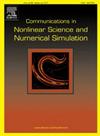A variable-step, structure-preserving and linear fully discrete scheme for the two-mode phase-field crystal model with face-centered-cubic ordering
IF 3.4
2区 数学
Q1 MATHEMATICS, APPLIED
Communications in Nonlinear Science and Numerical Simulation
Pub Date : 2025-03-20
DOI:10.1016/j.cnsns.2025.108766
引用次数: 0
Abstract
Combining the stabilized scalar auxiliary variable approach and the variable-step second-order backward difference formula, an adaptive time-stepping scheme is proposed for the two-mode phase-field crystal model with face-centered-cubic ordering. Specifically, introduce an auxiliary variable to handle the nonlinear term and obtain a new equivalent system, then perform a variable-step second-order approximation on the phase-field variable and a variable-step first-order approximation on the auxiliary variable, that is crucial for proving energy stability. Despite employing a low-order approximation for the auxiliary variable, as long as mild constraints are placed on the constant within this auxiliary variable, the second-order temporal accuracy of the phase-field variable will remain unaffected. By utilizing the boundedness of the norm for the numerical solution of the phase-field variable on nonuniform temporal grids, this paper performs a thorough error analysis of the fully discrete scheme. Some numerical simulations are conducted to verify the temporal accuracy, mass conservation, and energy dissipation. Additionally, to balance the efficiency and accuracy of the numerical experiments, we have selected an appropriate time-adaptive strategy for long-term simulations of phase transition behavior and crystal growth behavior of the phase-field variable.
面心立方有序双模相场晶体模型的变步长、结构保持和线性全离散格式
结合稳定标量辅助变量法和变步长二阶后向差分公式,提出了一种面心三次有序双模相场晶体模型的自适应时间步进方案。具体来说,引入辅助变量处理非线性项,得到一个新的等效系统,然后对相场变量进行变步长二阶逼近,对辅助变量进行变步长一阶逼近,这是证明能量稳定性的关键。尽管采用了辅助变量的低阶近似,但只要对该辅助变量内的常数施加温和的约束,相场变量的二阶时间精度将不受影响。利用非均匀时间网格上相场变量数值解的H4范数的有界性,对完全离散格式进行了彻底的误差分析。通过数值模拟验证了该方法的时间精度、质量守恒性和能量耗散性。此外,为了平衡数值实验的效率和准确性,我们选择了适当的时间自适应策略来长期模拟相场变量的相变行为和晶体生长行为。
本文章由计算机程序翻译,如有差异,请以英文原文为准。
求助全文
约1分钟内获得全文
求助全文
来源期刊

Communications in Nonlinear Science and Numerical Simulation
MATHEMATICS, APPLIED-MATHEMATICS, INTERDISCIPLINARY APPLICATIONS
CiteScore
6.80
自引率
7.70%
发文量
378
审稿时长
78 days
期刊介绍:
The journal publishes original research findings on experimental observation, mathematical modeling, theoretical analysis and numerical simulation, for more accurate description, better prediction or novel application, of nonlinear phenomena in science and engineering. It offers a venue for researchers to make rapid exchange of ideas and techniques in nonlinear science and complexity.
The submission of manuscripts with cross-disciplinary approaches in nonlinear science and complexity is particularly encouraged.
Topics of interest:
Nonlinear differential or delay equations, Lie group analysis and asymptotic methods, Discontinuous systems, Fractals, Fractional calculus and dynamics, Nonlinear effects in quantum mechanics, Nonlinear stochastic processes, Experimental nonlinear science, Time-series and signal analysis, Computational methods and simulations in nonlinear science and engineering, Control of dynamical systems, Synchronization, Lyapunov analysis, High-dimensional chaos and turbulence, Chaos in Hamiltonian systems, Integrable systems and solitons, Collective behavior in many-body systems, Biological physics and networks, Nonlinear mechanical systems, Complex systems and complexity.
No length limitation for contributions is set, but only concisely written manuscripts are published. Brief papers are published on the basis of Rapid Communications. Discussions of previously published papers are welcome.
 求助内容:
求助内容: 应助结果提醒方式:
应助结果提醒方式:


